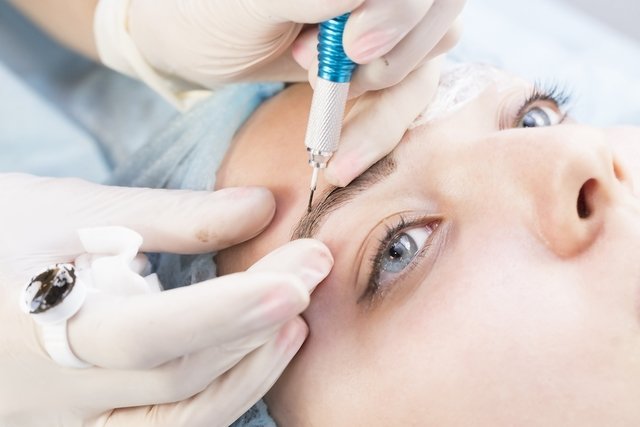Microblading is an aesthetic procedure for semi-permanent eyebrow pigmentation to leave them more defined, symmetrical and with a more beautiful and natural shape.
This procedure is carried out using a microblade with very fine needles, which deposit the pigment in the deepest layer of the skin, the dermis, creating lines similar to hair, and therefore giving a more natural appearance.
Microblading must be carried out in a beauty clinic, by a specialized professional, with sterile and disposable material, and with paint approved by Anvisa.

What is it for
Microblading serves to make eyebrows more defined, realistic and with a more beautiful and natural shape, semi-permanently.
This is because the pigments are applied to the dermis thread by thread to fill in the eyebrows, tattooing the thread in a similar way to natural eyebrow hair.
Microblading can be done by people who want a more natural appearance of their eyebrows and do not want it to be a permanent tattoo on the skin.
What is the difference between micropigmentation and microblading?
Both micropigmentation and microblading are semi-permanent aesthetic procedures that use pigments to fill in eyebrows thread by thread.
However, micropigmentation uses a device called a dermograph connected to an energy source and which has needles so that the pigment reaches the epidermis, which is the most superficial layer of the skin. Find out more about micropigmentation.
Microblading uses a manual, pen-shaped device that has small, very thin needles that reach the superficial dermis, which is the layer of skin just below the epidermis, depositing the pigment.
How to prepare
To prepare for microblading, you should avoid sunbathing for at least 3 days before the procedure, in addition to avoiding drinking alcoholic or caffeinated drinks for 24 hours before the procedure.
It is also recommended not to dye or wax your eyebrows and not to apply makeup before microblading.
How is done
Microblading is done in aesthetic clinics by a specialized professional.
To perform microblading, you must follow a few steps:
- Define eyebrow designdrawing its shape on the skin, with a pencil suitable for the skin;
- Apply a topical anestheticleaving it to act for a few minutes, to reduce the discomfort of the procedure;
- Perform skin asepsisto avoid infections;
- Prepare the pigment which must be the same shade as the original eyebrow;
- Prepare the tebori deviceconnecting the blade with the needles, which must be sterile and disposable, to the device handle;
- Dip the blade in the pigment and apply to the eyebrows in different directions to give the appearance similar to natural hairs;
- Remove excess pigment between applicationsusing sterile gauze with saline solution;
- Clean the skin at the end of the procedure.
The microblading procedure can last up to 2 hours and healing time is usually 2 weeks.
Or microblading lasts how long?
The duration of microblading varies from person to person, according to the characteristics of the skin, with the average duration being 6 months to 1 year.
Care after microblading
After the microblading procedure, it is important to take some precautions to avoid side effects and increase the durability of pigmentation:
- Do not touch your eyebrows for at least 48 hours after the procedure;
- Avoid applying makeup to your eyebrows;
- Do not pick at or remove scabs or scabs from your eyebrows;
- Avoid sunbathing or exposing your face to the sun for at least 4 weeks;
- Do not use exfoliants, use astringents or do peeling for up to 4 weeks.
Additionally, it is recommended not to wash or wet your eyebrows for at least 72 hours after the procedure. After this period, wash only with water and, if recommended, neutral or antibacterial soap.
Risks of microblading
The biggest risk of microblading is the development of infections, therefore, it must be done with sterile and disposable needles, in addition to following the recommended precautions after the procedure.
Furthermore, there is also a risk of allergy to the pigment used, which is why it is important to do an allergy test 48 hours before the procedure.
This test must be carried out by the professional who will perform the microblading, applying the pigment with a needle to the nape of the neck or behind the earlobe. If your skin becomes red or irritated, microblading is not recommended.
Who shouldn’t do
Microblading should not be done by children, pregnant or breastfeeding women.
Furthermore, this procedure is contraindicated for people who have been treated with isotretinoin in the last 6 months or used retinoid creams up to 7 days before the procedure.
Microblading should also not be done by people with a weakened immune system, who use blood thinners or who are undergoing cancer treatment.
Other contraindications for microblading are wounds or skin infections in the eyebrow region, peeling recent chemical or botox.
When to go to the doctor
It is important to consult a dermatologist if symptoms indicating infections or allergies to the pigment appear, such as bleeding in the eyebrows, fever, redness that worsens over time or the presence of pus or secretions in the eyebrows.
These symptoms should be evaluated by a dermatologist who can recommend the most appropriate treatment.
Make an appointment with a dermatologist in the nearest region:
Taking care of your health has never been easier!

Sign up for our newsletter and stay up to date with exclusive news
that can transform your routine!
Warning: Undefined array key "title" in /home/storelat/public_html/wp-content/plugins/link-whisper-premium/templates/frontend/related-posts.php on line 12
Warning: Undefined array key "title_tag" in /home/storelat/public_html/wp-content/plugins/link-whisper-premium/templates/frontend/related-posts.php on line 13



